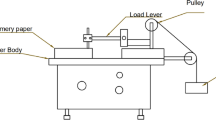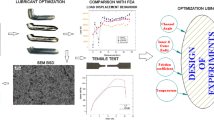Abstract
In this study, an experiment and a simulation were carried out on colliding an adhesively-bonded tapered double cantilever beam (TDCB) at the impact velocities of 5 m/s, 7.5 m/s and 12.5 m/s. The analysis method of the corrected beam theory (CBT) was used to obtain the rate of energy release in the bonded area according to the crack progression, and a simulation was performed to determine the maximum strain energy during the impact analysis as a means to examine the mechanical properties of aluminium alloy. The experimental data were found to be higher than the simulation data. This is deemed to explicable by the fact that the adhesive strength was maintained even after the specimen separated in the experiment. Crack progression occurred, irrespective of the impact velocity, and high strain energy occurred at the end of the bonded region, thereby causing the strain energy to increase in the final stages. Also, the maximum load applied on the pin and the maximum strain energy in the bonded area were shown increase at higher impact velocities. The results of the experiment and simulation performed in this study are expected to serve as important data in developing a safety design for composite materials that can help prevent the progression of cracks caused by impact.
Similar content being viewed by others
References
D. G. Liee, K. S. Kim and Y. T. Im, An experimental study of fatigue strength for adhesively bonded tubular single joints, International Journal of Adhesives, 35 (1991) 39–53.
C. Kadar, F. Chmelik and Z. Rajkovits, Acoustic emission measurements on metal foams [J], Journal of Alloys and Compounds, 378 (2003) 145–150.
J. Pang, Y, Du and K. Y. Wu, Fatigue analysis of adhesive joints under vibration loading, International Journal of Adhesion & Adhesives, 89 (2013) 899–920.
R. C. Batra and Z. Peng, Development of shear bands in dynamic plane strain compression of depleted uranium and tungsten blocks [J], International Journal of Impact Engineering, 16 (3) (1995) 375–395.
L. D. Kenny, Mechanical properties of particle stabilized aluminum foam [J], Materials Science Forum, 217–222 (3) (1996) 1883–1890.
P. Briskham and G. Smith, Cyclic stress durability testing of lap shear joints exposed to hot-wet conditions, International Journal of Adhesion and Adhesives, 20 (1) (2000) 33–38.
T. Mukai, T. Miyoshi, S. Nakano, H. Somekawa and K. Higashi, Compressive response of a closed-cell aluminum foam at high strain rate [J], Scripta Materialia, 54 (4) (2006) 533–537.
J. U. Cho, S. J. Hong, S. K. Lee and C. Cho, Impact fracture behavior at the material of aluminum foam [J], Materials Science and Engineering A, 539 (2012) 250–258.
X. Teng and T. Wierzbicki, Dynamic shear plugging of beams and plates with an advancing crack [J], International Journal of Impact Engineering, 31 (2005) 667–698.
T. Børvik, O. S. Hopperstad, M. Langseth and K. A. Malo, Effects of target thickness in blunt projectile penetration of Weldox 460 E steel plates [J], International Journal of Impact Engineering, 28 (4) (2003) 413–464.
X. W. Chen and Q. M. Li, Shear plugging and perforation of ductile circular plates truck by a blunt projectile [J], International Journal of Impact Engineering, 28 (2003) 513–536.
A. Pirondi and G. Nicoletto, Fatigue crack growth in bonded DCB specimens, Engineering Fracture Mechanics, 71 (2004) 859–871.
M. M. Shokrieh, M. Heidari-Rarani and S. Rahimi, Influence of curved delamination front on toughness of multidirectional DCB specimens, Composite Structures, 94 (4) (2012) 1359–1365.
B. R. K. Blackman, J. P. Dear, A. J. Kinloch, H. MacGillivray, Y. Wang, J. G. Williams and P. Yayla, The failure of fibre composites and adhesively bonded fibre composites under high rates of test part III mixed-mode I/II and mode II loadings, Journal of Materials Science, 31 (17) 4467–4477.
K. R. Pradeep, B. Nageswara Rao, S. M. Srinivasan and K. Balasubramaniam, Interface fracture assessment on honeycomb sandwich composite DCB specimens, Engineering Fracture Mechanics, 93 (2012) 108–118.
S. Marzi, A. Biel and U. Stigh, On experimental methods to investigate the effect of layer thickness on the fracture behavior of adhesively bonded joints, International Journal of Adhesion and Adhesives, 31 (8) (2011) 840–850.
P. Qiao, J. Wang and J. F. Davalos, Tapered beam on elastic foundation model for compliance rate change of TDCB Specimen, Engineering Fracture Mechanics, 70 (2) (2003) 339–353.
J. U. Cho, A. Kinloch, B. Blackman, S. Rodriguez, C. D. Cho and S. K. Lee, Fracture behavior of adhesively-bonded composite materials under impact loading, International Journal of Precision Engineering and Manufacturing, 11 (1) (2010) 89–95.
V. Cooper, A. Ivankovic, A. Karac, D. McAuliffe and N. Murphy, Effects of bond gap thickness on the fracture of nano-toughened epoxy adhesive joints, Polymer, 53 (24) (2012) 5540–5553.
N. Michailidis, F. Stergioudi, H. Omar and D. N. Tsipas, An image-based reconstruction of the 3D geometry of an Al open-cell foam and FEM modeling of the material response, Mechanics of Materials, 42 (2) (2010) 142–147.
S. K. Parida and A. K. Pradhan, 3D finite element analysis of stress distributions and strain energy release rates for adhesive bonded flat composite lap shear joints having preexisting delaminations, Journal of Mechanical Science and Technology, 28 (2) (2014) 481–488.
J. U. Cho, S. K. Lee, C. Cho, F. S. Rodriguez Sanchez, B. R. K. Blackman and A. J. Kinloch, A study on the impact behavior of adhesively-bonded composite materials, Journal of Mechanical Science and Technology, 21 (10) (2007) 1671–1676.
Author information
Authors and Affiliations
Corresponding author
Additional information
Recommended by Chief-in-Editor Emeriti Haecheon Choi
Teng-Gao received his B.S. degree in in Div. of Mechanical & Automotive Engineering from Kongju University, Korea, in 2013. Now he is at the course of M.S. degree in Mechanical Engineering at Graduate School of Kongju University. He is interested in the areas of fracture mechanics (dynamic impact), composite material, fatigue and strength evaluation.
Jae-Ung Cho received his M.S. and Doctor Degrees in Mechanical Engineering from Inha University, Incheon, Korea, in 1982 and 1986, respectively. Now he is a professor in Mechanical & Automotive Engineering of Kongju National University, Korea. He is interested in the areas of fracture mechanics (dynamic impact), composite material, fatigue and strength evaluation, and so on.
Rights and permissions
About this article
Cite this article
Gao, T., Kinloch, A.J., Blackman, B.R.K. et al. A study of the impact properties of adhesively-bonded aluminum alloy based on impact velocity. J Mech Sci Technol 29, 493–499 (2015). https://doi.org/10.1007/s12206-015-0109-y
Received:
Revised:
Accepted:
Published:
Issue Date:
DOI: https://doi.org/10.1007/s12206-015-0109-y




